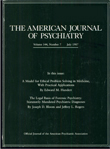Effect of a Haloperidol Challenge on Regional Brain Metabolism in Neuroleptic-Responsive and Nonresponsive Schizophrenic Patients
Abstract
OBJECTIVE: The CNS metabolic response to a neuroleptic challenge in treatment-responsive and nonresponsive schizophrenic patients was measured in order to examine the relation between treatment outcome and the capacity to alter neurochemical function in response to acute receptor blockade. METHOD: Positron emission tomography (PET) and [18F]fluorodeoxyglucose (FDG) were used to measure regional cerebral metabolism in seven schizophrenic patients judged to have been responsive to drug treatment previously and seven nonresponsive schizophrenic patients after a drug-free period of at least 3 weeks (baseline) and again 12 hours after administration of 5.0 mg of haloperidol. RESULTS: The haloperidol challenge caused widespread decreases in absolute metabolism in the nonresponsive patients but not the responsive patients. These group differences reflect the findings on the second (challenge) scans, since metabolic values at baseline were not statistically different in the two groups. The pattern of decreased metabolic activity in the nonresponders after the haloperidol challenge is similar to that previously observed in normal subjects. CONCLUSIONS: The metabolic response to drug challenge separates treatment responders from nonresponders and normal subjects. The results suggest that subtyping of schizophrenia (and other psychiatric disorders) can be achieved by measuring the physiologic response to a pharmacologic challenge in vivo with chemical brain-imaging techniques.



